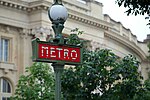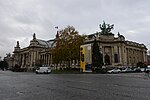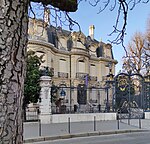Cirque d'Été

The Cirque d'Été (Summer Circus), a former Parisian equestrian theatre (and a type of indoor hippodrome), was built in 1841 to designs by the architect Jacques Hittorff. It was used as the summer home of the Théâtre Franconi, the equestrian troupe of the Cirque Olympique, the license for which had been sold in 1836 to Louis Dejean by Adolphe Franconi, the grandson of its founder, Antonio Franconi. The cirque was later also used for other purposes, including grand concerts conducted by Hector Berlioz. The new theatre was located on the north-east side of the present Rond-Point of the Champs-Élysées. At first called the Cirque National, it also became known as the Cirque des Champs-Élysées and the Cirque Olympique des Champs-Élysées. In 1853 it was renamed Cirque de l'Impératrice (in honor of the new Empress Eugénie), a name which it retained until the fall of the empire in 1870. The cirque on the Champs-Élysées should not be confused with the same company's winter theatre, the Cirque Olympique on the Boulevard du Temple, which had opened in 1827, or with the company's later winter theatre, the Cirque Napoléon (on the rue des Filles Calvaires), also built for Louis Dejean and opened in 1852. The latter theatre dropped the name Cirque Napoléon in 1870 and became primarily known as the Cirque d'Hiver (Winter Circus). The theatre on the Champs-Élysées was demolished in 1902.
Excerpt from the Wikipedia article Cirque d'Été (License: CC BY-SA 3.0, Authors, Images).Cirque d'Été
Avenue des Champs-Élysées, Paris 8th Arrondissement of Paris (Paris)
Geographical coordinates (GPS) Address Nearby Places Show on map
Geographical coordinates (GPS)
| Latitude | Longitude |
|---|---|
| N 48.8692 ° | E 2.3119 ° |
Address
Carré Marigny
Avenue des Champs-Élysées
75008 Paris, 8th Arrondissement of Paris (Paris)
Ile-de-France, France
Open on Google Maps








